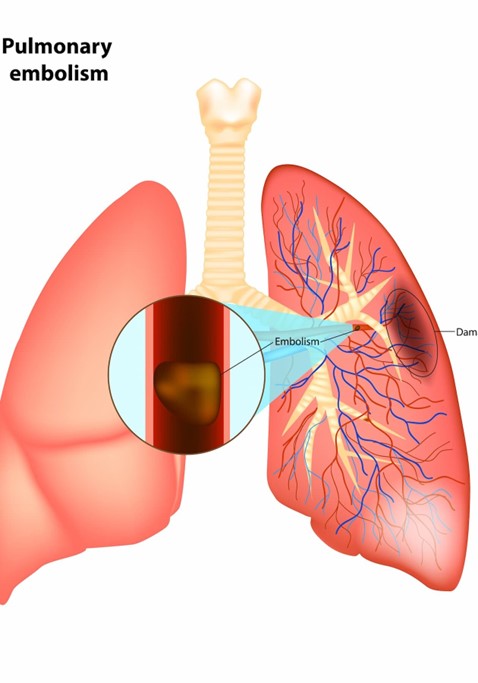Days after surgical fixation of a fractured femur, a client suddenly reports chest pain and difficulty in breathing. The nurse suspects that the client had a pulmonary embolus. Which action should the nurse take first?
Notify the healthcare provider.
Prepare a continuous heparin infusion per protocol.
Provide supplemental oxygen.
Bring the emergency crash cart to the bedside.
The Correct Answer is C
Choice C is correct because providing supplemental oxygen is the first action that the nurse should take for a client who has a suspected pulmonary embolus. A pulmonary embolus is a life-threatening condition that occurs when a blood clot travels to the lungs and blocks the blood flow, causing hypoxia and respiratory distress. The nurse should administer oxygen to improve the client's oxygenation and prevent further complications.
Choice A is incorrect because notifying the healthcare provider is not the first action that the nurse should take for a client who has a suspected pulmonary embolus. The nurse should notify the healthcare provider after providing supplemental oxygen and assessing the client's vital signs and symptoms.
Choice B is incorrect because preparing a continuous heparin infusion per protocol is not the first action that the nurse should take for a client who has a suspected pulmonary embolus. Heparin is an anticoagulant that can prevent further clot formation and reduce the risk of recurrence, but it does not dissolve existing clots or improve oxygenation. The nurse should prepare a heparin infusion after obtaining a prescription from the healthcare provider and confirming the diagnosis with diagnostic tests.
Choice D is incorrect because bringing the emergency crash cart to the bedside is not the first action that the nurse should take for a client who has a suspected pulmonary embolus. The emergency crash cart contains equipment and medications that can be used in case of cardiac arrest or other emergencies, but it does not address the immediate need of oxygenation. The nurse should bring the emergency crash cart to the bedside after providing supplemental oxygen and assessing the client's condition.

Nursing Test Bank
Naxlex Comprehensive Predictor Exams
Related Questions
Correct Answer is D
Explanation
Choice A: Client’s healthcare power of attorney. This is not the first information that the nurse should provide, as it does not address the current situation or problem of the client. The healthcare power of attorney is a legal document that designates who can make medical decisions for the client if they are unable to do so themselves.
Choice B: Currently prescribed medications. This is not the first information that the nurse should provide, as it does not address the current situation or problem of the client. The currently prescribed medications are a part of the background information that can help explain the client’s medical history and potential causes of confusion.
Choice C: Fall at home as reason for admission. This is not the first information that the nurse should provide, as it does not address the current situation or problem of the client. The fall at home is a part of the background information that can help explain the client’s reason for admission and potential injuries.
Choice D: Increasing confusion of the client. This is the first information that the nurse should provide, as it addresses the current situation or problem of the client. The increasing confusion of the client is a part of the assessment information that can help identify the urgency and severity of the issue and guide further interventions.
Correct Answer is B
Explanation
Choice A: Determining the need for urinary catheterization is not a task that the nurse should assign to the PN, as this requires clinical judgment and critical thinking, which are beyond the scope of practice of the PN. This is a distractor choice.
Choice B: Titrating oxygen to prescribed parameters is a task that the nurse can assign to the PN, as this involves following orders and protocols, which are within the scope of practice of the PN. Therefore, this is the correct choice.
Choice C: Receiving a postoperative client and conducting the assessment is not a task that the nurse should assign to the PN, as this requires initial assessment and data collection, which are the responsibility of the registered nurse. This is another distractor choice.
Choice D: Evaluating and updating plans of care for clients is not a task that the nurse should assign to the PN, as this requires nursing diagnosis and outcome identification, which are part of the nursing process that only the registered nurse can perform. This is another distractor choice.
Whether you are a student looking to ace your exams or a practicing nurse seeking to enhance your expertise , our nursing education contents will empower you with the confidence and competence to make a difference in the lives of patients and become a respected leader in the healthcare field.
Visit Naxlex, invest in your future and unlock endless possibilities with our unparalleled nursing education contents today
Report Wrong Answer on the Current Question
Do you disagree with the answer? If yes, what is your expected answer? Explain.
Kindly be descriptive with the issue you are facing.
